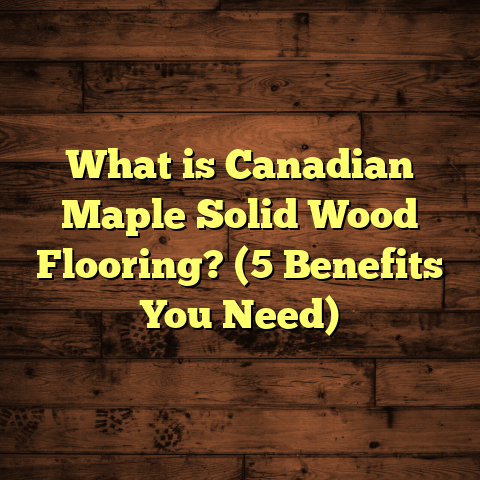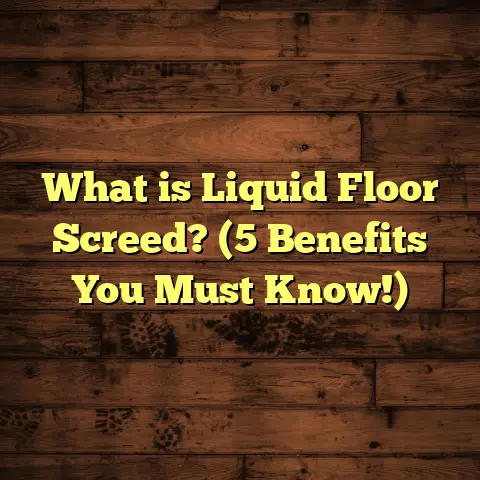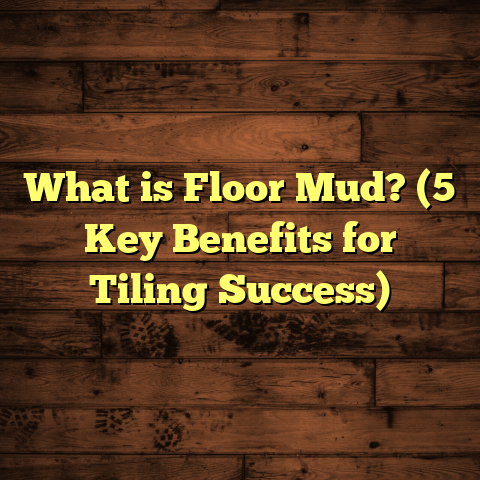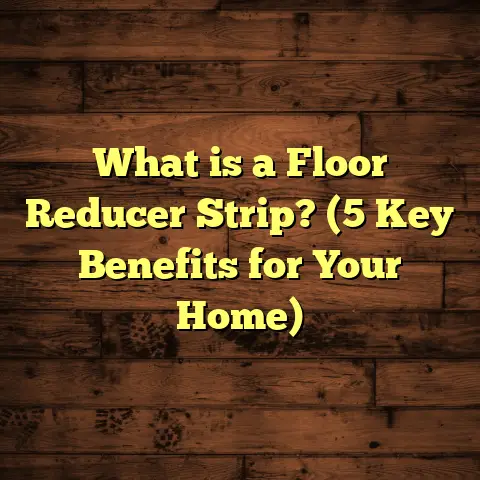What is the Most Durable Flooring? (5 Options You Need Now!)
“I just want a floor that lasts forever without losing its charm,” my client told me one afternoon while we sat in her living room surrounded by sample boards. I could feel the weight behind that simple wish—durability and beauty rolled into one. It’s a request I hear often. Durable flooring is one of the biggest priorities for homeowners who don’t want to replace or repair floors every few years.
So, what makes flooring durable? How do you pick the best material for your needs? Over years in the flooring business, I’ve worked with dozens of materials and seen which ones truly stand up to wear and tear. I’ll walk you through five flooring options that offer exceptional durability — sharing technical details, manufacturing secrets, maintenance tips, and real client stories. Whether you’re remodeling a busy family home or outfitting a commercial space, this guide will help you choose a floor that lasts.
What is the Most Durable Flooring?
The term “durable flooring” might seem straightforward, but it covers several attributes: resistance to scratches, dents, moisture, stains, fading, and general wear from foot traffic. In essence, durability means how well a floor stays functional and attractive over years despite daily use.
Technical Aspects of Durability
Manufacturers and industry experts measure durability through several tests:
- Hardness: Usually measured by the Janka hardness test for wood species. This test measures the force needed to embed a 0.444-inch steel ball halfway into the wood surface. The higher the number (in pounds-force), the harder the wood.
- Abrasion Resistance: Evaluated through ASTM D4060 testing, where a machine rubs abrasive material on the surface repeatedly to simulate wear.
- Water Absorption: For tiles and vinyl, water absorption rates (measured in percentages) indicate how porous a material is. Lower values mean better moisture resistance.
- Impact Resistance: Measures how well flooring withstands dropped objects or sudden forces without cracking or denting.
- Scratch Resistance: Evaluated often by coatings and surface treatments like aluminum oxide layers on wood floors or urethane layers on vinyl.
Manufacturing Processes Affect Durability
How a floor is made influences its lifespan:
- Solid Hardwood: Sawn from a single piece of wood and sanded smooth. Can be refinished multiple times.
- Engineered Hardwood: Multiple plywood or fiberboard layers topped with a hardwood veneer; more stable in humid environments.
- Porcelain Tile: Made from refined clay fired at very high temperatures (~1200°C), resulting in a dense, hard surface.
- Luxury Vinyl Plank (LVP): Composed of PVC layers with a printed design layer and a thick wear layer made from urethane or aluminum oxide.
- Concrete: Poured as a slab then polished and sealed; densifiers penetrate to harden the surface.
1. Porcelain Tile — The Heavyweight Champion
If toughness had a champion in flooring, porcelain tile would most likely take the title.
What Makes Porcelain So Durable?
Porcelain is fired at temperatures between 1200°C and 1400°C (2192°F to 2552°F), which is significantly higher than ceramic tile (which fires around 1000°C). This intense firing vitrifies the material — turning it into a glass-like, non-porous substance.
Due to this process:
- Water Absorption Rate: Porcelain absorbs less than 0.5% water, sometimes as low as 0.1%. This makes it ideal for bathrooms, kitchens, and even outdoor spaces.
- Scratch Resistance: High Mohs hardness rating (6-7), meaning it resists scratches from knives, keys, or even some metals.
- Stain Resistance: Non-porous surface resists stains from wine, coffee, and oils.
- Chemical Resistance: Very resistant to cleaning chemicals and acids used in household cleaners.
Manufacturing Details
Porcelain tile starts as a mix of fine kaolin clay combined with quartz and feldspar. This mixture is pressed into molds under high pressure before firing. Some porcelain tiles are glazed with a protective layer; others are unglazed but polished for shine.
There are two main types of porcelain tiles:
- Glazed Porcelain: Has decorative glazes that add color and pattern but still retain durability.
- Unglazed Porcelain (Through-Body): The color runs throughout the tile’s body so chips and scratches don’t show easily.
Real-Life Experience
I installed porcelain tile for a restaurant kitchen where grease spills and heavy foot traffic are constant. After three years, the floor showed zero signs of damage — no cracks or stains. The owner said cleaning was easy too; mopping removed any residue quickly without dulling the shine.
Maintenance Tips for Porcelain
Porcelain tiles require minimal maintenance:
- Regular sweeping or vacuuming prevents dirt buildup.
- Damp mop with neutral pH cleaners.
- Seal grout lines every year or two to prevent staining.
Cost Factors
Porcelain tile can range from $3 to $10 per square foot for material alone. Installation costs vary based on complexity but usually run $5-$15 per square foot because cutting and setting tiles requires skill.
2. Luxury Vinyl Plank (LVP) — Durability Meets Style
Luxury vinyl plank has revolutionized flooring by combining durability with aesthetics — providing realistic wood or stone looks without sacrificing toughness.
What Makes LVP Durable?
LVP consists of multiple layers:
- Wear Layer: This is the outermost coating that protects against scratches, scuffs, and stains. Thickness varies but 20 mil (0.5 mm) or more is ideal for residential use; commercial-grade can be 30 mil or thicker.
- Printed Design Layer: A high-resolution photographic film replicates wood grain or stone textures.
- Core Layer: Usually made from PVC or WPC (wood plastic composite), providing rigidity and waterproof qualities.
- Backing Layer: Adds stability and cushioning underneath.
The wear layer often contains aluminum oxide particles similar to those used in hardwood finishes, making it highly scratch-resistant.
Technical Specs
- Thickness: Typically between 4mm to 8mm.
- Water Resistance: 100% waterproof if properly installed with sealed seams.
- Impact Resistance: Flexible enough to absorb shocks from dropped objects without cracking.
Personal Story
In a home with two energetic kids and a big golden retriever, I recommended LVP in the playroom and mudroom. After two years of spills, muddy paws, dropped toys, and furniture moves — the floor looked as good as day one. The family appreciated how easy it was to clean up messes quickly.
Installation Insight
LVP can be installed as floating floors over many subfloors including concrete and existing hardwood — making it a favorite for remodeling projects due to speed and cost savings.
Maintenance Made Simple
No waxing needed; just sweep regularly and mop with water-based cleaners. Avoid abrasive pads that can wear the protective layer prematurely.
Cost Overview
Materials typically cost $2 to $7 per square foot; installation runs $1.50 to $4 per square foot depending on site conditions.
3. Solid Hardwood — Timeless Toughness
Solid hardwood is often considered a gold standard in flooring because of its natural beauty coupled with its ability to last generations.
Hardness Matters: Picking the Right Species
Not all hardwoods are created equal when it comes to durability:
| Wood Species | Janka Hardness (lbs) | Notes |
|---|---|---|
| Hickory | 1820 | Very hard; great for heavy traffic |
| White Oak | 1360 | Popular in homes; durable |
| Maple | 1450 | Dense and abrasion-resistant |
| Cherry | 950 | Softer but ages beautifully |
| Pine | 420 | Soft; dents easily |
I always advise clients to choose wood species based on their lifestyle — pets and kids mean harder woods will resist dents better.
Manufacturing & Finishing
Solid hardwood boards are milled from single logs into planks between 3/4” thick typically. They’re sanded smooth then coated with:
- Polyurethane finishes (oil-based or water-based): Add scratch resistance.
- Aluminum oxide coatings: Extremely durable finish that can extend life between refinishing.
You can sand these floors multiple times (usually 4-6 times) over their lifespan to restore appearance.
Real-Life Example
A client’s historic home had oak floors over 100 years old. Despite decades of traffic, sanding away surface scratches restored the original beauty again and again — proving hardwood’s repairability is unmatched.
Vulnerabilities
While tough on impact and scratches (if properly finished), solid hardwood can suffer from:
- Moisture damage causing cupping/warping
- Scratches from sharp objects
- Sunlight fading if not protected by rugs or window treatments
Proper installation includes acclimating wood to home humidity levels before laying down planks.
Maintenance Tips
Sweep regularly; avoid excessive water during cleaning. Use felt pads under furniture legs to prevent dents.
Cost Consideration
Solid hardwood costs range widely: $5-$15 per square foot for material plus $3-$8 for installation depending on species and finish.
4. Engineered Hardwood — Stability with Strength
Engineered hardwood offers many of solid wood’s benefits but improves dimensional stability by using layered construction.
How Engineered Hardwood Is Made
It consists of:
- Top Veneer Layer: Thin slice (1mm to 6mm) of real hardwood.
- Core Layers: Usually plywood or high-density fiberboard arranged crosswise for stability.
- Backing Layer: Balances construction preventing warping.
Durability Factors
The wear layer thickness determines refinishing potential:
- Thin veneers (1–2 mm) usually cannot be sanded.
- Thicker veneers (3–6 mm) allow multiple refinishings.
Most engineered floors have factory-applied aluminum oxide finishes for scratch resistance.
Installation Flexibility
Engineered hardwood can be glued down, nailed, or floated over various subfloors including concrete slabs where solid wood would fail due to moisture.
Case Study
I installed engineered hardwood in a condo with radiant heating beneath floors — solid hardwood would have warped due to temperature changes but engineered planks stayed flat and durable over several years.
Maintenance & Care
Same as solid hardwood: avoid standing water; clean gently; use protective pads on furniture.
Price Range
Materials cost $4-$12 per square foot; installation varies $3-$7 depending on method used.
5. Concrete Floors — Industrial Strength for Homes
Concrete floors have evolved beyond utilitarian garages into stylish, durable living spaces in modern homes.
Why Concrete Is So Tough
Concrete gains strength as it cures over time through hydration reactions between cement and water forming calcium silicate hydrate crystals that harden the slab.
- Compressive strength typically ranges from 3000 to 5000 psi (pounds per square inch).
- Surface densifiers penetrate pores filling voids making it harder and less dusty.
- Polishing adds smoothness and shine while increasing abrasion resistance.
Manufacturing & Finishing Techniques
Polished concrete floors go through grinding steps using diamond abrasives from coarse grit down to fine grit. After polishing:
- Densifiers are applied that chemically react within the concrete.
- Sealants protect against stains and moisture penetration.
Benefits in Homes
Concrete is impervious to:
- Water damage
- Scratches
- Heavy impacts
- Stains when sealed properly
It’s also hypoallergenic—no dust mites or allergens trapped like carpet fibers.
My Client Story
A couple converted their basement into an entertainment room with polished concrete floors. They loved how low maintenance and tough it was despite kids running around with skateboards indoors!
Challenges & Comfort Tips
Concrete can be cold and hard underfoot—adding area rugs or radiant heating improves comfort significantly.
Additional Insights: Comparing Durability Factors Side by Side
| Flooring Type | Scratch Resistance | Moisture Resistance | Repairability | Longevity | Comfort |
|---|---|---|---|---|---|
| Porcelain Tile | Very High | Very High | Moderate (grout) | 50+ years | Hard/Cold |
| Luxury Vinyl Plank | High | Very High | Limited | 15–25 years | Soft/Resilient |
| Solid Hardwood | Moderate–High | Low–Moderate | High (sanding) | 50+ years | Warm/Comfortable |
| Engineered Hardwood | Moderate–High | Moderate | Moderate | 20–40 years | Warm/Comfortable |
| Concrete | Very High | Very High | Moderate | 50+ years | Hard/Cold |
Environmental Considerations & Sustainability
Durability also ties into sustainability—long-lasting floors reduce waste by avoiding frequent replacement.
- Porcelain Tile: Made from natural clays but energy-intensive firing process.
- LVP: Contains PVC which is less eco-friendly; look for products with recycled content or certifications.
- Solid Hardwood: Renewable if sourced responsibly (FSC-certified).
- Engineered Hardwood: Uses less hardwood per plank; plywood cores may come from sustainable sources.
- Concrete: High carbon footprint during production but long lifespan offsets impact somewhat.
Maintenance: How Durability Depends on Care
Even the toughest floors need care:
- Sweep/vacuum regularly
- Use mats at entrances
- Wipe spills immediately
- Protect against furniture scratches
- Apply sealers/finishes when recommended
Neglecting maintenance can reduce lifespan regardless of material quality.
Frequently Asked Questions About Durable Flooring
Q: Can I install durable flooring myself?
A: Some options like LVP have DIY-friendly click-lock systems; porcelain tile usually requires professional installation to avoid uneven surfaces or cracking.
Q: Which floor works best with radiant heating?
A: Engineered hardwood and LVP perform well; solid hardwood can work if acclimated properly; porcelain tile is excellent heat conductor but cold without heating underneath.
Q: How do pet nails affect different floors?
A: LVP resists scratches well; hardwood can dent but sanding helps; porcelain is very scratch-resistant; concrete won’t show scratches but pets can slip on polished surfaces.
Final Thoughts on Choosing Your Durable Floor
Deciding on durable flooring means balancing toughness with aesthetics, budget, comfort, and lifestyle needs. Each option has strengths depending on where it’s installed:
- Porcelain tile shines in wet areas needing heavy wear resistance.
- Luxury vinyl plank offers waterproof durability plus warmth underfoot.
- Solid hardwood brings classic beauty plus generations of refinishing potential.
- Engineered hardwood blends beauty with moisture stability.
- Concrete delivers unbeaten toughness with modern style in appropriate spaces.
I encourage you to think about your day-to-day use, maintenance willingness, and design preferences before choosing your floor — durability alone doesn’t guarantee satisfaction if other factors aren’t right for your home.
If you want help running numbers using tools like FloorTally for budgeting or want detailed installation advice tailored to your project specifics, just ask!
Would you like me to add specific sections such as detailed installation guides or maintenance checklists next?





